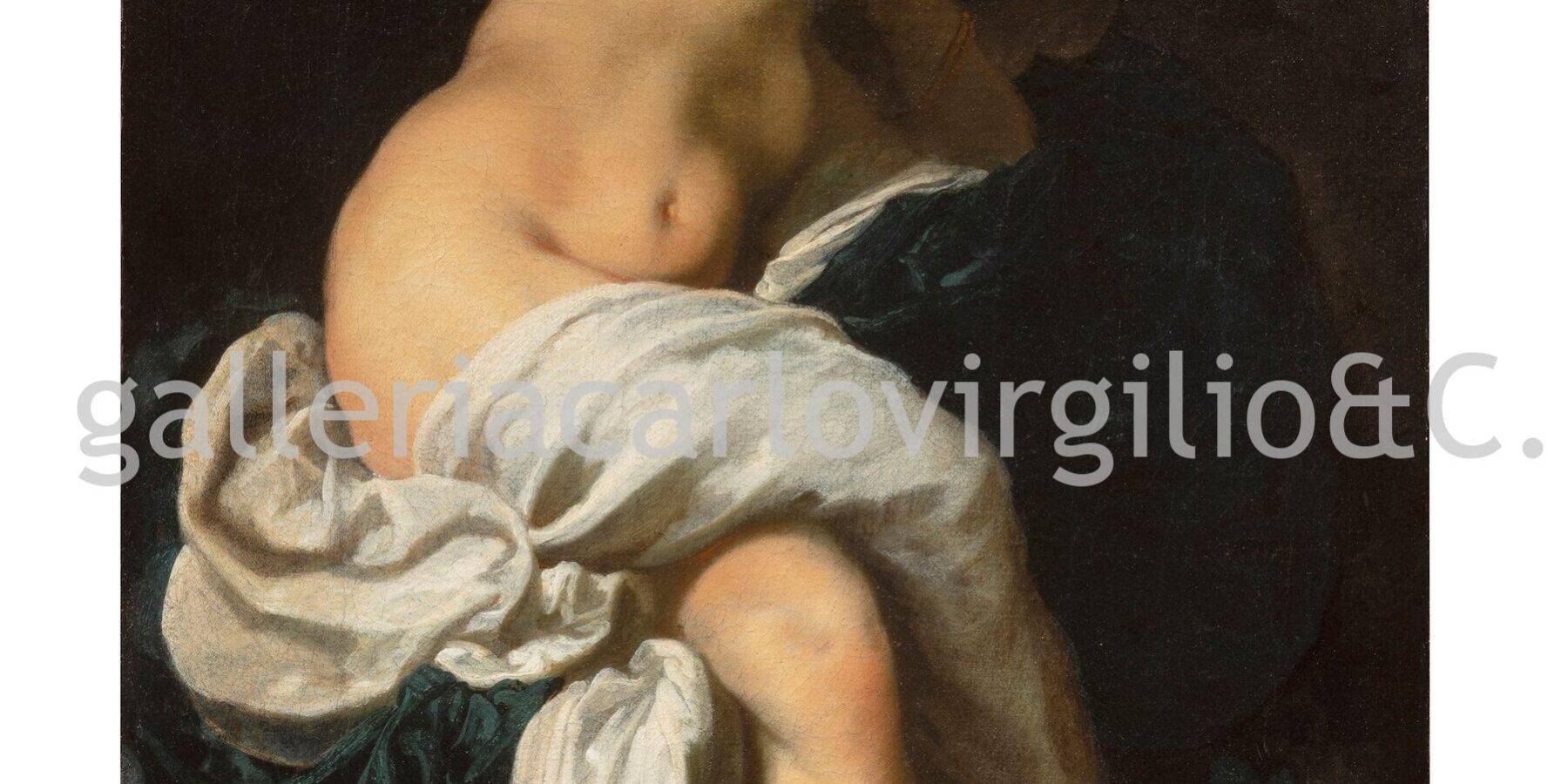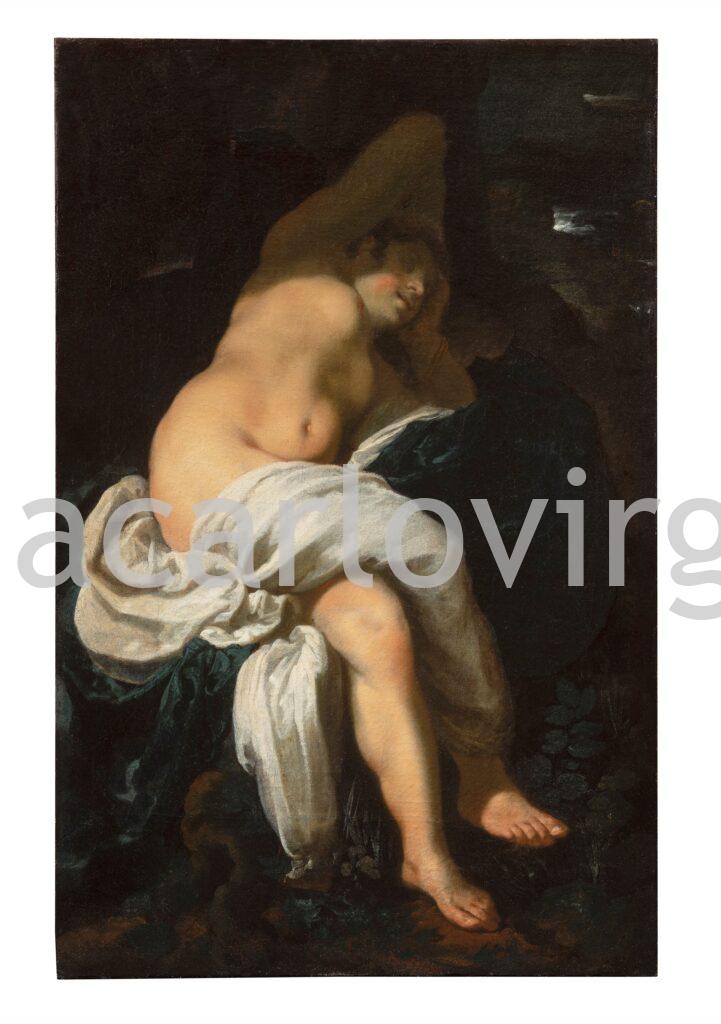| NOT AVAILABLE

Johann Liss
Oldenburg 1595/97-Verona1631
Sleeping Nymph • 1619-25
Oil on canvas, 67,5 x 43,5 cm
This exquisite painting of a sensual female figure asleep might portray a nymph, considering the rustic setting, while the detail in the top right, a nocturnal gleam, could suggest it is Ariadne asleep, abandoned by Theseus on the island of Naxos. As becomes apparent in the following discussion, the first hypothesis is more coherent.
In excellent condition, the canvas was recently cleaned and restored, returning the original brilliant colour accents to the multilayered, soft paint.
The piece is the work of Johann Liss, native to Oldenburg, in the north of Germany, who had a brilliant if fleeting career on a European scale.
Johann Liss’ artistic training and education are complex and extremely rich: going from the initial rudiments received from his parents, both painters, to the various experiences in different countries starting with a sojourn in Amsterdam around 1615 and ending with his untimely death in Verona in 1631, after contracting the plague in Venice around 1629 and 1630. Biographic and documentary information concerning the artist is scarce, and derived mainly from Joachim von Sandrart (1606-1688; 1675, ed. 1925, pp. 187-188) who knew him personally in Venice in 1629. According to his account, Liss first trained with Hendrick Goltzius (1558-1617) then in Haarlem with Frans Hals (1580-16669, Dirck Hals (1591-1656), Willem Buytewetch (591/92-1624) and the late mannerists of that school. This work experience provided the confidence of his drawing and his sensual approach to anatomic portrayal.
His next visit, to Antwerp, was fundamental for the acquaintance of Rubens (1577-1640), the young Jacob Jordaens (1593-1678) and Abraham Janssens (1573/74-1632), figures that left a decisive stamp on his style, about which critics are agreed (Klessmann, 1999, pp. 11-23), bringing a vertiginous development to the orientation of his artistic personality.
A brief visit to Paris preceded Liss’ arrival in Venice around 1620; this first experience is characterised by his encounter with the great examples of Venetian painting of the Cinquecento and with contemporaries Domenico Fetti (1589-1623) and Nicolò Renieri (1591-1667).
Later – probably around 1623 – the painter travelled to Rome, where he experienced an intense and vortex-like update that included the followers of Caravaggio (1571-1610), Annibale Carracci (1560-1609), and the works of Nordic artists, Adam Elsheimer (1578-1610), Paul Bril (1544-1626) and Cornelis van Poelenburgh (1594/95-1667). Here Liss integrates perfectly with the Roman scene: he frequents the Bentvueghels, the boisterous and dissolute group of Nordic artists (Lemoine, 2014, pp. 23-41) and he assumes the moniker of Pan, to indicate exuberance and vitality associated with licentiousness of the mythological figure.
Around 1625, the artist returned to Venice, where his outstanding wealth of experience and contacts bring him commissions, but he also works from inspiration, above all at night, until his early death.
In the painting in question the mythological theme shows the artist’s compositional and receptive style with regard to the great examples of Cinquecento Venetian painting, in primis Titian (1488/90-1576), and not forgetting the Emilians, in particular Correggio (1489-1534): the soft sensuality of the figure slumbering with her arm behind her head recalls Sleeping Antiope at the Musée du Louvre, Paris. Such elements in his painting also link to the artist’s Roman experience of the Carraccis’ painting and that of van Poelenburgh.
Comparisons with other paintings by Liss are notable, as his varied and eclectic production includes mythological and pastoral subjects. In particular Nymph and Shepherd at the Metropolitan Museum, New York: as the sleeping figures share anatomy, sumptuous soft rendering and chromatic range.
There are also convincing similarities to Nymphs Bathing (now entitled Salmacis and Hermaphrodite), in Augsburg (Klessmann, 1999, cat. n. 126, pp. 159-160; Trepesch, in Die deutsche Barokgalerie…, 2016, cat. n. 72). The German painting has the same free brushstroke, the rich and consistent pictorial matter, as well as dark, rapid intonation in the background. However, the most surprising aspect is the structure and composition of the Augsburg canvas: setting out from the Steinbart’s research (1959, p. 175f.), it was noticed that the painting had been reduced on the left, the original composition being identifiable in a drawing attributed to Aegidius Sadeler (1570-1629) conserved in the Cabinet des Dessins at the Louvre (F. Lugt, 1949, II, n. 1280; Klessmann, 1999, p. 159, fig. 70, p. 74). It is undeniable that the figure on the left, now no longer visible in the Augsburg painting, coincides perfectly with that in our painting. Following Klessmann it becomes clear that the Augsburg canvas was reduced on the left by about a third, an operation substantiated by scrutiny of the support, which presents cuts on the left hand edge. Hence, the proposition is that the eliminated part of the German painting is the one under examination here. Not least because Galleria Virgilio’s work has clearly been cut along the right hand edge. A further element supporting the unity of the two canvases is the stitching that appears right the way across the lower part, present in both paintings and visible in the reproduction of the painting (fig. 1a); interestingly the stitching is also present in the New York painting, unequivocally pointing to use of the same roll of canvas.
The attribution to Liss of the paintings cited has never been contested; indeed the presence of small pentimenti in the Augsburg painting is a sure sign of the artist’s creative process.
More complex is dating the works, in general on the basis of the stylistic elements and assimilation of Italian models, the New York and Augsburg paintings are given a date coming into the artist’s Roman period – which is to say 1625 – a chronological location that must however be reconsidered in the light of comparison with a later drawing by Sadeler connected to the New York painting. In the detailed information available on the Metropolitan Museum site (entry: Joshua P. Watermann 2012: Johann Liss/Nymph and Shepherd/The Metropolitan Museum of Art), reference is made to a communication from Doroty Limouze in 2004 mentioning a drawing by Aegidius Sadeler conserved at the Hermitage Museum, St. Petersburg, with the same composition as the New York painting, in an extended version. Hence, the New York painting was also reduced by a third: on the right it included the figure of a nymph sitting on the bank of a brook. Here too a technical examination has confirmed that the canvas was reduced, this time along the right side. On the one hand therefore, the presence of another Sadeler drawing would confirm Liss’ compositions were copied by Sadeler in view of a series of reproduction prints, either not realised or lost (and not the opposite, as Limouze suggested for the drawing in the Louvre and the Augsburg painting; cfr. D.A. Limouze, 1997, p. 438, n. I.236); on the other hand, the presence of the date 1619 on the Hermitage drawing compels us to review the chronology of the works, shifting their execution to before the artist’s arrival in Venice. Although it must be said that in Holland there were collections boasting the works of Italian artists and numerous reproduction prints, not to mention the shining example of Rubens, untiring populariser of Italian figurative culture. Liss also refers to the Flemish master in technical choices, obvious in our painting, such as preparing a cold colour base for areas of flesh, then moving on to pinkish, warm tones to recall the throb of life.
BIBLIOGRAPHY
1675
Joachim von Sandrart, Teutsche Akademie der Bau-, Bild-, und Mahlerey-Künste, Nürnberg, 1675-1679, ed. A.R. Pelttzer, Munich, 1925
1949
Frits Lugt, Musée du Louvre. Inventaire Général des dessins des écoles du Nord. Ècole flamande, II, Paris 1949
1959
Kurt Steinbart, Das Werk des Johann Liss in alter und neuer Sicht, in “Saggie memorie di storia dell’arte”, II, 1959, pp. 159-206
1997
Doroty A. Limouze, Engraving at the court of Prague, in Rudolf II and Prague, catalogo della mostra a cura di Eliška Fučiková, London, Thames and Hudson 1997, pp.172-178
1999
Rüdiger Klessmann, Johann Liss. A Monograph and Catalogue Raisonné, Doornspijk, Davaco Publishers, 1999
2014
Annick Lemoine, Sotto gli auspici di Bacco. La Roma dei bassifondi, da Caravaggio ai Bentvueghels, in I bassifondi del Barocco, catalogo della mostra a cura di F. Cappelletti e A. Lemoine, Roma, Accademia di Francia villa Medici, Paris, Petit Palais, 2014-2015, Milano, Officina libraria 2014, pp. 23-41
2016
Christof Trepesch (a cura di) Die deutsche Barokgalerie im Schaezlerpalais Meister Werke der Ausburger Sammlung, Berlin-München, Deutscher Kunstverlag 2016
The Carlo Virgilio & C. Gallery searches for works by Liss Johann (1595/97-1631)
To buy or sell works by Liss Johann (1595/97-1631) or to request free estimates and evaluations
mail info@carlovirgilio.co.uk
whatsapp +39 3382427650
